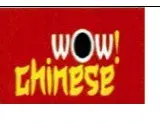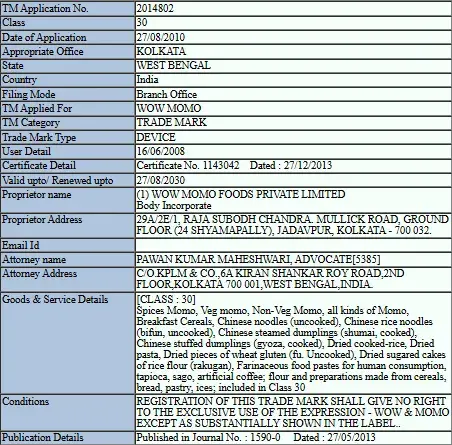By Vikrant Rana, Rima Majumdar and Aashi Nema
Introduction
In a major development for Indian trademark jurisprudence, a Division Bench of the Delhi High Court comprising of HMJ C. Hari Shankar and HMJ Om Prakash Shukla, on October 16, 2025, set aside a single Judge’s Order dated September 12, 2025 which had refused interim injunction to Wow Momo Foods Pvt. Ltd. in its suit against Wow Burger & Anr. The Division Bench held that the Single Judge erred in treating WOW as a mere laudatory term and failing to appreciate that WOW MOMO and WOW BURGER are deceptively similar when viewed as composite marks. The Division Bench allowed the appeal and granted interim relief to the Appellant, marking an important shift in the treatment of common expressions used in brand families.
Background
The Appellant, established in Kolkata, began its journey with the mark ‘WOW! / WOW MOMO’ in the year 2008. The Appellant’s trademark registrations for WOW! formative trademarks are as under:
| Trade Mark | Reg. No. | Class | User Detail | Date of Registration |
| WOW MOMO | 4665747 | 29 | June 16, 2008 | September 21, 2020 |
 |
2014802 | 30 | June 16, 2008 | August 27, 2010 |
 |
2831210 | 30 | June 16, 2008 | October 22, 2014 |
| WOW DIMSUMS | 3301059 | 35 | June 16, 2008 | July 04, 2016 |
 |
4665744 | 29 | June 16, 2008 | September 21, 2020 |
 |
5291474 | 35 | June 16, 2009 | January 19, 2022 |
 |
5412947 | 32 | June 16, 2009 | April 18, 2022 |
 |
5321648 | 30 | November 28, 2018 | February 09, 2022 |
 |
5412950 | 43 | November 28, 2018 | April 18, 2022 |
 |
5510349 | 29 | April 12, 2021 | June 29, 2022 |
| WOW MOMO
INSTANT |
5510352 | 29 | April 12, 2021 | June 29, 2022 |
 |
5667535 | 9 | PTU | November 02, 2022 |
 |
5860011 | 30 | PTU | March 23, 2023 |
About the Dispute: The dispute arose in December 2024 when the Appellant discovered, via a LinkedIn post about the Respondent’s intention to launch a business in India under the mark ‘WOW BURGER/![]() /
/ ’.Being aggrieved from the said mark in respect of identical goods and services, the Appellant filed a trademark infringement suit before Hon’ble High Court of Delhi. The Single Judge, in the order dated 12 September 2025, dismissed the injunction plea holding that “WOW” is a common laudatory English word, incapable of monopoly, and that WOW MOMO and WOW BURGER were visually and conceptually dissimilar. Hence, the Appellant filed an Appeal before the Division Bench of Delhi High Court.
’.Being aggrieved from the said mark in respect of identical goods and services, the Appellant filed a trademark infringement suit before Hon’ble High Court of Delhi. The Single Judge, in the order dated 12 September 2025, dismissed the injunction plea holding that “WOW” is a common laudatory English word, incapable of monopoly, and that WOW MOMO and WOW BURGER were visually and conceptually dissimilar. Hence, the Appellant filed an Appeal before the Division Bench of Delhi High Court.
Appellant’s Arguments
- The Respondents have slavishly copied the dominant/essential feature of the mark ‘WOW’ for identical goods and services. Even when compared as a whole, the marks are exactly similar.
- Respondent’s ‘WOW!’ series of trademarks have acquired ‘secondary meaning’ owing to their continuous and extensive use since 2008.
- The Appellant also addressed the existence of disclaimers on some of their trademark registrations, including ‘WOW! MOMO’,‘WOW! MOMO’, ‘WOW! THUNDERZZ’, ‘WOW! CHINA’, ‘WOW! CHINESE’. It was argued that these disclaimers did not prevent the Appellant from enforcing its rights over a part of the trademark against a third party. Similarly, the Appellant’s previous legal stand that that the mark of the Appellant is formed by combination of an English Dictionary words ‘WOW’ and ‘CHINA/CHINESE’ taken before the Registrar of Trademarks were argued not to constitute an estoppel in the present proceedings.

- A pivotal claim in the Appellant’s case was the assertion that it adopted and continuously used the mark ‘WOW!BURGER’ since 2009 for selling burgers in their restaurants. This claim was used to establish a direct conflict between the Appellant’s and Respondent’s marks, arguing that the Respondent’s mark was identical or deceptively similar to their own.
Single Bench’s Analysis
No trademark registration of “WOW”/ “WOW BURGER”: The Court’s fundamental finding was that Appellant does not have a registration for the standalone mark WOW, nor does it have a registration for the composite mark WOW BURGER. Additionally the Appellant also could not show use of the mark WOW BURGER through documentary evidence.
- WOW is not distinctive mark of the Appellant: The Court analyzed the dictionary meaning of the term ‘WOW!’ and held that it is a word conveying the praise or describing the quality or characteristics of goods or services for which it is being used. Therefore, the Court asserted that no one can be allowed to have exclusive monopoly over the term ‘WOW!’
In this respect, the Hon’ble Court placed reliance on Pernod Ricard India (P) Ltd. Vs. Karanveer Singh Chhabra (2025 SCC OnLine SC 1701), while noting that “It is a well-established principle of trademark law that generic, descriptive, or laudatory terms – particularly those commonly used in a given trade – cannot be monopolized by any one proprietor”. The Court also considered landmark rulings dealing with the same issue by referring to the cases of Institute of Directors Vs. Worlddevcorp Technology and Business Solutions Pvt. Ltd., CS (COMM) 611/2023 and Yatra Online Limited Vs. Mach Conferences and Events Limited, CS(COMM) 1099/2024 Additionally, in the case of Marico Limited Vs. Agro Tech Food Limited, FAO(OS) No. 352/2010 the Division Bench of Delhi High Court held that even tweaking of a common English word does not merit trademark protection. - Prosecution History Estoppel: The Court also examined the Appellant’s reply to objections raised against its trademark applications for “WOW CHINA” and “WOW! CHINESE”. In these replies, the Appellant admitted that its mark was “formed by a combination of an English dictionary word WOW suffixed with CHINA/CHINESE”. Thus, the Appellant cannot be allowed to approbate and reprobate by taking a different stand in Court from the one it took before the Registrar, by now saying that the WOW has acquired secondary meaning alone outside the composite mark for which they acquired protection.
- Secondary Meaning: The court relied on the ratio of PhonePe Pvt. Ltd Vs. EZY Services & Anr, for the proposition that “It is important to note that acquisition of a secondary meaning is not to be readily assumed.” The court perused Appellant’s documents and found that “WOW! BURGER” was used only as a “menu item” and not as a trademark or brand. Later on, they stopped using it as a menu item and started using MOBURG instead. This shows that Appellant has a distinct name for its burger items instead of ‘WOW! BURGER.
- Comparison of competing marks: The Appellant contends that the competing marks should be assessed in their entirety yet Appellant failed to consider the whole composite mark “WOW! MOMO” but rather concentration is made on “WOW!”. Therefore, the court denied the assertion of the mark “WOW!” to be the source identifier. Composite mark is to be evaluated as a whole, as noted in the anti-dissection rule.
The Court also noted differences in the two marks such as colour theme, layout, theme, stylization etc. as depicted below:
Findings of the Division Bench in Appeal
- Error in Treating “WOW” as a Laudatory Word:
The Bench held that the Single Judge erred by isolating “WOW” and ignoring its use in a composite expression. While “WOW” per se is a common exclamation, the Court clarified that when combined with a food item (WOW! MOMO, WOW BURGER, WOW DIMSUMS), the mark becomes distinctive because the exclamation is not descriptive of the goods. The Court noted that, “The idea of combining an exclamation with the name of a food item is inventive and distinctive.” Thus, WOW BURGER imitated the distinctive composite structure coined by WOW MOMO which amounted to “idea infringement”. - Likelihood of Association and Initial Interest Confusion:
Applying the “consumer of average intelligence and imperfect recollection” test and the doctrine of initial interest confusion, the Bench found that an ordinary consumer encountering WOW BURGER would naturally assume an association with WOW MOMO. The Court further noted that “It would be normal for any average consumer… to presume that the appellant has now launched a burger range under the name WOW BURGER.” This likelihood of association sufficed to establish infringement under Section 29(2)(b). - Distinction Between Infringement and Passing OffThe Division Bench emphasized that infringement is a statutory violation, unlike passing off, which is based on deception. Hence, factors like packaging, color scheme, and get-up are irrelevant once similarity between marks is established. The Single Judge’s reliance on visual differences was misplaced.
- Application of the “Dominant Feature” and “Family of Marks” Doctrines
The Bench recognized that WOW MOMO owns a “family of marks”—including WOW DIMSUMS, WOW CHINA, WOW MOMO INSTANT, etc.—where “WOW” is the dominant prefix consistently used in the same line of business. The Court observed that, “Where an entity has a family of registered marks in all of which the dominant feature is common, it is entitled to protection against use of the same dominant feature by another.” Accordingly, “WOW” had acquired distinctiveness through consistent and extensive use in multiple food categories, strengthening the Appellant’s claim. - Disclaimers and Lack of Standalone Registration Irrelevant
The Bench clarified that disclaimers against exclusive rights in “WOW” did not dilute rights over the composite marks as a whole. Even though “WOW” was not separately registered, the Court held that under Sections 17(1) and (2), protection extends to the whole registered mark and any deceptively similar marks.
Judgment Summary
The Division Bench allowed the appeal and held that:
- WOW MOMO, WOW DIMSUMS, and WOW MOMO INSTANT are distinctive marks.
- The Defendant/Respondent’s mark WOW BURGER infringes the Appellant’s registered marks by creating a likelihood of association.
- “WOW” when used as a prefix in connection with food items has acquired distinctiveness as part of a series mark.
The Single Judge’s focus on the laudatory nature of “WOW” and visual differences between device marks was misplaced.
Interim injunction should be granted in favor of Wow Momo Foods Pvt. Ltd.
Author’s Note:
The Division Bench’s ruling below reinforces key principles in our view:
- Series/Family of Marks Doctrine: Consistent use of a prefix or suffix can create protectable brand identity. The Appellant has consistently used the “WOW!” formative in a “family of marks”, including WOW! MOMO, WOW! CHINA, WOW! CHINESE, WOW! DIMSUMS, and WOW! CHIPS. Each of these marks has been extensively advertised, used across India, and is identified with the Appellant’s restaurant chain.In such circumstances, Courts have recognized that use of a series of marks sharing a common prefix or suffix may establish a protectable association in the minds of consumers, even if one particular mark in the series is not registered or independently distinctive. While “WOW” may be a common English word, its consistent and exclusive association with the Appellant’s line of food and restaurant services could have rendered it distinctive. The Appellant’s “WOW” formative has achieved source-identifying significance through a “family of marks” approach, akin to how “Mc” in McDonald’s or “APPLE” in Apple Music / Apple Pay / Apple TV, TATA, Mankind, etc. have acquired secondary meaning, despite being common dictionary words.
- Reaffirmation of Initial Interest Confusion: Even transient confusion at first sight suffices to establish infringement in trademark law. The replication of a brand’s conceptual formulation can itself constitute infringement.
- Narrow Reading of “Secondary Meaning”: The factual context in Wow Momo is significantly different from cases relied upon by the Single Bench. The Appellant has used “WOW!” continuously since 2008, invested substantially in nationwide marketing, and expanded its operations into multiple product categories. The Single Bench’s finding that “WOW! BURGER” appeared only as a menu item may be factually correct but misses the larger issue, namely, that the root formative “WOW!” had already achieved secondary meaning by virtue of extensive use across multiple product lines. Thus, even if the Appellant did not use “WOW! BURGER” as a standalone trademark, consumers could still reasonably perceive “WOW BURGER” as a natural extension of the Appellant’s established “WOW!” brand identity.
- Incomplete Consideration of “Likelihood of Association” Test: It is a well-established principle that marks must be considered from the standpoint of an average consumer with imperfect recollection, not through a dissectional or linguistic analysis. Consumers encountering “WOW BURGER” in the same food and restaurant sector might reasonably assume a commercial association or extension of the Appellant’s business. The judgment seems to downplay this test by treating “WOW” as a descriptive exclamation rather than as a trade-origin indicator developed through consistent branding.
- Registration Certificate is only relevant document post registration: As held in Telecare Network India Pvt. Ltd. Vs. Asus Technology Pvt. Ltd. & Ors., “In any event, as there is no estoppel against statute, the stand taken by plaintiff in reply to the examination report is not relevant” In this case, the Court has categorically held that post grant of registration of the mark, neither the examination report nor the reply to the examination report are relevant documents. Thus, in the present case, Court has wrongly relied on prosecution history estopple.
- Incomplete Consideration of the “WOW! Series” as a Business Identifier: The Court’s reasoning compartmentalized each “WOW!” formative mark instead of considering the holistic brand equity created by the Appellant over nearly two decades. The trademark value lies in the composite consumer impression rather than separate word analysis. The Court’s failure to recognize this evolution in branding could be challenged as it is inconsistent with consumer perception-based jurisprudence.
Conclusion
The Delhi High Court’s Division Bench has reaffirmed that the test of trademark infringement is one of consumer perception, not dictionary semantics. By recognizing the WOW! formative as distinctive within the “WOW!” family of marks, the Court has provided vital protection for established brands using consistent prefixes or suffixes. This ruling underscores that creativity in brand formulation deserves protection, even when it draws from common language, provided it has acquired secondary significance through consistent use.


